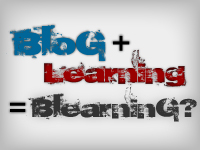Resources at a Glance
Get connected
Write It
Personal "Blearning" (Posting reflections)
 Personal "blearning" (blog learning) can be a great way to create and archive your personal thoughts and observations on the world at large. And it’s available for the world at large to see, making it possible for your thoughts and observations to influence others’ thoughts and observations (perhaps the Web blog should have been called the "We blog"). And blogging helps people to write, write, write. But make sure your writing is thoughtful. Anyone can type on a screen. The blog format calls for more than just words. It calls for brains. It calls for eloquence. It calls for creativity and resourcefulness. Do you have what it takes?
Personal "blearning" (blog learning) can be a great way to create and archive your personal thoughts and observations on the world at large. And it’s available for the world at large to see, making it possible for your thoughts and observations to influence others’ thoughts and observations (perhaps the Web blog should have been called the "We blog"). And blogging helps people to write, write, write. But make sure your writing is thoughtful. Anyone can type on a screen. The blog format calls for more than just words. It calls for brains. It calls for eloquence. It calls for creativity and resourcefulness. Do you have what it takes?
Publish another short blog post (100-300 words) on your personal blog (instructor’s role) about the use of blogs for educational purposes. Express your inner thoughts on blogs and learning. Don’t hold back! (Okay, hold back a little.)
Send us the URL so we can be proud of you.
Public "Blearning" (Comments and Teams)
Public "blearning" (blog learning) opens up whole new avenues of interaction and perspective. Publishing comments allows blog readers and writers to enter a community of learning, and to provide feedback and peer review for blog writers (which may be just the impetus they were needing to keep writing). One-way communication suddenly becomes two-way communication, allowing for greater perspective, dialogue, and reflection. Remember, actors often respond better to an audience than to empty seats (and they also get sick to their stomachs from nerves). Having students comment on each others’ blogs can help them to "kick it up a notch."
Are you ready to enter the wonderful world of educational blogging completely? Do the following assignment and see what you’re made of.
Find an established blog related to your content area of interest, and submit a comment on it. Post a comment on an instructional-related blog (you may use the Learning to Blog, Blogging to Learn blog on Wordpress.com, or post a URL for the blog on which you left a comment, and copy the text into your own blog) in which you describe how you would like to use blogging in learning/teaching in the future.
Send us the URL so we can see how well you did.
The power of "Blinking" (You link to the world, the world links to you)
One of the great things about the Web is its interconnected nature (that’s why it’s called the "Web"). You can turn the World Wide Web into the Web of learning by sharing resources in your blog posts. This is a great way to archive what you’ve found and to highlight content for others to use and share. In this way, your blog can become a sort of portal to the world of online resources in your content area. Students are given a voice in the composition of class content resources by being assigned tasks in which they must find course-related content online themselves (you can give them a head start by pointing them in the right direction).
Remember when searching for new resources that Google can be your best friend. Also remember to read through and review the resource you are linking to from your blog (to ensure that it is fully appropriate, relevant, and correct).
By using your educational blogs as linking resource portals, you can help to increase the interconnectedness of learning and instill a mindset in the student that we can all learn all the time.
Publish a short blog post on your personal blog (instructor’s role) and refer to (and link to) at least three online learning resources identifying the potential benefits of using each of them. Write on one of the following topics:
- Web 2.0 and education
- Online classrooms
- Wikis
- How easy it is to use blogs
- How hard it is to use blogs
- How your students will learn to use blogs
- How your students will learn while using blogs
Send us the URL so we can see how your words are connecting with the world.
Final Thoughts
Final? No way! I’ll be blogging about it for some time. And hopefully so will you.

